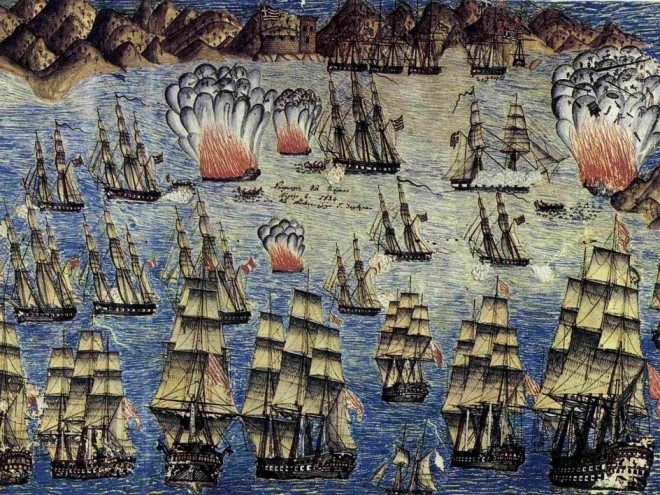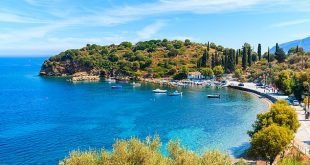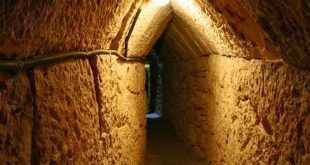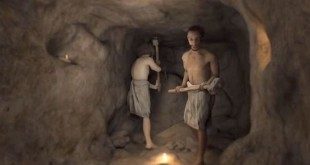A text (or document) for the local anniversary of August 6, written by Mr. Christos Landros
The description of the Naval Battle of Samos (4-6 August 1824) was written by the admirals who participated in the battle, which took place between the Island of Samos and the opposite Asia Minor coast.
It has also been described by the Samos General Headquarters in which, by orders of Logothetis Lykourgos, a detailed “Diary” was kept under the general title “Newspaper of the Deeds of the General Government House of Samos”. This document is stored in the General State Archives in Samos (Folder C1 of the 1821 War of Independence Document Collection). The bulk of these documents are yet to be published. However, the reference to the events made by Nicholas and Epaminondas Stamatiades are based on these documents. An extract from the Diary was published in the 2nd issue of the journal “Apoplous”1 coupled with comments.
The Naval Battle of Samos took place “in front of the fortress”, i.e. the sea area between Tigani (Samos) and the opposite Asia Minor coast. It began at the end of July 1824 when the Ottoman Navy besieged Samos in order to conquest the Island. The Ottoman Fleet, which was campaigning in the Aegean Islands, was planning to join the Egyptian Fleet and, combined, to set sail for Peloponnese, land, and defeat decisively the Greek revolutionary forces, thereby ending the Greek War of Independence, which had begun in 1821. Any kind or form of resistance the Ottomans encountered was treated with harsh measures, severe military action, and complete destruction, as an example for other revolutionaries. Thus, the Ottoman Fleet landed and destroyed the Island of Psara (west of the Island of Chios), while the Egyptian Fleet landed and destroyed the Island of Kasos (north-east of the island of Crete). Samos was saved thanks to its well organized defenses, the combined action of the united Greek Fleet which was composed by ships from the islands of Hydra, Spetses, and Psara, and the skillful naval commanders, namely Sachtouris, Tsamados, Androutsos, Apostolis, and Kanaris. The Greek Fleet was informed in time by Lykourgos Logothetis and asked to sail towards Samos as soon as possible in order to deal with the imminent danger. The Ottoman Fleet, under the command of Mehmet Hüsrev Pasha, circumnavigated the island and tried, repeatedly, but unsuccessfully, to make a landing on the northern coast near Karlovassi and Kotsika. All landing attempts were successfully repelled by Samians in accordance with the defense plan prepared by Lykourgos Logothetis long ago2.
Logothetis, elected General Commander and General (since the early 1824), was well aware of the preparations and the plan of the Ottoman Fleet. So he fortified a fortress and placed cannons in the hill of Kastro (fortress) in Tigani area, where an old Byzantine castle preexisted. He also organized specific defense sectors for the residents of each village who would protect the entire coastline of the Island. The largest defensive force was concentrated in the plain of Chora, in the area from the fortress all the way down to Heraion. Other coasts, where it was likely to become landing zones were well fortified with observation posts or trenches. A system of optical telegraphy was installed in Kerkis Mountain, all the way to his headquarters, allowing Logothetis to learn, in time, the movements of the Ottoman Fleet and to dispatch orders quickly to his forces. The responsibility for coordination in Samos was at the hands of four officers (Captains): Captain Stamatis Georgiadis, Captain Constantine Lachanas, Captain Constantine Kontaxis, and Captain Manolis Angelinidis. ________________________________________________
- Ch. Landros, «And thus the war ended…» An account for the events that took place in Samos in August 1824 from the unpublished diary of Lykourgos Logothetis, “Apoplous”, Issue 2/3, Samos, 1990, Pages 108-116
- Ν. Stamatiades, “Samian”, Volume B, Pages 236-238
_________________________________________________
The great conflict between the Greek and the Ottoman Fleet took place in the eve of the feast of the Transfiguration of Jesus, and ended in Greek victory, while the Ottomans suffered serious damages. Following the battle, the Ottomans abandoned any other attempt to seize the Island. The threat was over. The victory of the Greek Fleet was the first major naval victory of the Greek War of Independence and had positive effects for Samos and the other Aegean Islands, the Peloponnese, and the War of Independence itself. Logothetis and the General Assembly of Samos linked the lifesaving victory to the Christian feast and immediately changed the official stamp of the Assembly to depict the Transfiguration of Jesus with the inscription “CHRIST SAVED SAMOS, SIXTH OF AUGUST”. At the same time the Samians decided to build a church in the fortress area dedicated to the Transfiguration of Jesus, as an expression of gratitude for the salvation of the Island.
The Naval Battle of Samos was painted by Panayiotis Zografos of Makrygiannis with the inscription “Battle of Samos, 6 August 1824”. This is the proper term of the event: “Naval Battle of Samos” and should not be confused with the ancient Battle of Mycale (took place in 479 BC, at the same sea area).
Since 1824 and up until today the event is celebrated in Samos with splendor in the glorious Church of the Transfiguration of Jesus, built next to the fortress of Lykourgos Logothetis. Since 1888 is a local Samian national holiday (following a decision made by the Samian Parliament). The extract from Lycourgos’s Diary covers the period between 29 July 1824 and 25 September 1824.
The language is simple and understandable. Only some words sound strangely today. For example, the Ottoman Fleet is called “Byzantine” because it sailed from Constantinople, the capital city of the Byzantine Empire (build in the ruins of the ancient Greek city of Byzantium). Those who warned the villages and carried the orders from the headquarters were either runners or horse riders. The verb “kanonizo” means cannon fires. The recording of the events in the Diary is made with clarity and seriousness, yet the enthusiasm of the author is clear.
The Document
In July 29, Tuesday was the day, the Byzantine Fleet reached Samos, consisting of some 200 ships, small and big, and anchored in the area of Karlovassi. Some of the ships left the Fleet, sailed and reached Kuşadası (located in the opposite Asia Minor coast). The news where quickly dispatched via telegraph and the couriers. In all villages of Samos, armed Samians prepared to resist the enemy. The inhabitants of Karlovassi and many of the inhabitants of the surrounding villages moved to the nearby beach and manned the necessary positions, especially in Seitani, because the place was surrounded by the enemy’s fleet by afternoon. Enemy ships reached Samos in the morning and ever since bombarded the Island continuously until sunset.
In July 30, Wednesday was the day, the enemy ships settled in Chora, where general Lykourgos has already moved in the fortress, along with many men, during the past night. Big enemy ships, accompanied a great number of small boats, remained afloat and patrolled the Icarian Sea up to Karlovassi. Between the enemy ships and the boats 22 Greek ships took up positions, by the early morning, and straight away intercepted many enemy boats. Some were chased away, some were sunk, and some were taken and entered captivity. By afternoon the Greek ships and the captured enemy boats reached and anchored in Mesokampon.
All day long, enemy ships did nothing but to patrol the area and observe our positions, especially those in the fortress. The small boats were anchored in Kanapitzan.
In July 31, Thursday was the day, midday, enemy ships set sail towards Kavos Zorzi. There, in formation, bombarded the Greek ships and the fortress. The Greek ships engaged the enemy for three hours, but in vain. So in the afternoon the enemy ships retreated towards Gadoronisi, while the Greek ones returned to Mesokampon.
In August 1, Friday was the day, a battle took place between the Ottoman and the Greek ships, lasting for three hours, until sunset. Now one won the battle. Many cannon balls were fired against the fortress but no serious damage was made. Only three cannon balls (some 23 kg each) hit the seaside wall of the fortress, which split in two pieces and fall to the sea.
In August 2, Saturday was the day, there was no war.
In August 3, Sunday was the day, midday, took place the naval battle. The enemy ships stormed and approached the Greek ones. The Greeks fighting bravely forced some of the enemy ships into the retreat. At 17:00, near Kanapitzan, the Greeks burned the largest and fastest enemy frigate. The enemy, angry as it was, sent 12 more ships, one of witch (the tripolinikon) lead the charge and fought bravely, but it was surrounded by two Greek fire ships. After a brave resistance it was burned down by one of the two Greek fire ships in 19:00 near Kavos Zorzi. Following this the Greek ships and 14 enemy ships fought intensively and in 22:00 the Greek burned another enemy frigate opposite the fortress and so the battle ended, which was the most horrible of all the previous naval battles fought by the Greeks. The first frigate was destroyed by two fire ships, tripolinikon by one, and the second frigate by two, while another fire ship headed towards another frigate but missed and it was burned down. The first frigate burned and sunk in Kanapitzan while flames also burned the nearby fishing boats and many Turks who had set their camp in the coast. Many Turks were killed, along with those who threw themselves into the sea, out of fear like the frogs do, and many other ships, which were very close to the burning frigate. This Greek victory scared the enemy to such a degree that enemy ships didn’t made any other attempt to engage the Greek Fleet again, while the Ottoman armies, stationed in the opposite Asia Minor coast, began fleeing. Day after day more and more Greek ships reached Samos and now the combined Greek Fleet numbers 50 ships.
From Wednesday until Saturday, August 9, the enemy Fleet watched from the distance the Greek ships sailing towards Gadoronison. The Greek ships formed a battle line opposite the Ottoman Fleet day after day. But the Ottomans didn’t dare to approach and engage again. In Saturday the Ottoman Fleet sailed towards the Island of Kos and vanished.
In August 10, Sunday was the day, our ships sailed towards a place called Spilia but due to the strong opposite winds failed to inflict any kind of damage to the enemy ships stationed there.
In August 11, Monday was the day, several letters were issued and dispatched from the headquarters to the villages, regarding provisions, i.e. ox and goats, for the Greek ships, which every village had to supply in accordance with its capacity. The letters also called for the provision of troops in accordance with the capacity of each village, in order to cover the needs of the motherland, and of the ships, on behalf of the sick elderly (for them I had written many times in the past but in vain, as well as for many other interests of the motherland). The letters also called for an assembly in order to correct the current situation of thinks that cause internal anomaly.
In the evening the last four enemy ships left Spilia and set sail for Tzatalia. We observe their route but we couldn’t chase them down. During the following night we heard some ten cannon fires.
In August 15, Friday, the day of Dormition of the Mother of God, the commander held a meeting with the four Admirals, on the ship of Admiral N. Apostolis from Psara (anchored in Mesokampos). That day the Greek ships received many ox and goats offered by the villages of Samos.
In August 16, Saturday was the day, the Greek Fleet, composed of some 38 ships, left Mesokampos and set sail for the islands of Leros and Kalimnos, in order to observe the movements of the enemy Fleet. Only one ship was left behind in order to collect, from the sea, the spoils left behind by the burned enemy ships.
In August 18, in Chora took place a local assembly, where it was decided the correction of all existing irregularities. Thus a relative declaration was announced throughout the Island ordering the restoration of an official from each village, and all the local captains being placed under the command of the General Command and the elderlies, in order to act and impose law, order, and security for the motherland in accordance with the existing crucial occasion. So it was decided the establishment of a Pouleti within three days in order to save ammunition and other pressing needs.
In the evening the caique of Stefanis Hrapis was dispatched, carrying letters for the Greek Fleet, in order to bring back news.
In the following day, August 19, the caique returned and brought news from the Vice-Admirals that due to the strong winds the Greek Fleet is currently located in the Island of Patmos and they couldn’t move towards the enemy, but they intend to do so when weather conditions improve.
August 20, 21, 22, Wednesday, Thursday, and Friday, due to the strong winds we couldn’t learn anything, but from a French ship we learned that the two enemy Fleets united. It is however unknown where are intent to strike.
August 23, Saturday, an English frigate along with a brig, coming from Smyrna and Kousadassi, informed us that in the area of Kousadassi they saw some 20 caiques and 4.000 troops waiting.
During Sunday, noon, cannon fires began to echo from the direction south of the small Island of Agathonisi. Cannon fires continued until one o’clock pass midnight, thus we concluded that a great naval battle too place. Some also say that they observed ships south of Agathonisi. In the evening we dispatched letters to all villages to send troops in the outposts just in case.
August 25, Monday, we sent a fast boat in order to learn about the outcome of the naval battle.
Ch. Landros
Philologist, former head of the General State Archives in Samos
 iSamos.gr Η ενημερωτική σελίδα της Σάμου! Εξερευνήστε τη Σάμο, τις παραλίες της, τη φύση της, τις ομορφιές της. Διαβάστε την ιστορία της Σάμου
iSamos.gr Η ενημερωτική σελίδα της Σάμου! Εξερευνήστε τη Σάμο, τις παραλίες της, τη φύση της, τις ομορφιές της. Διαβάστε την ιστορία της Σάμου






